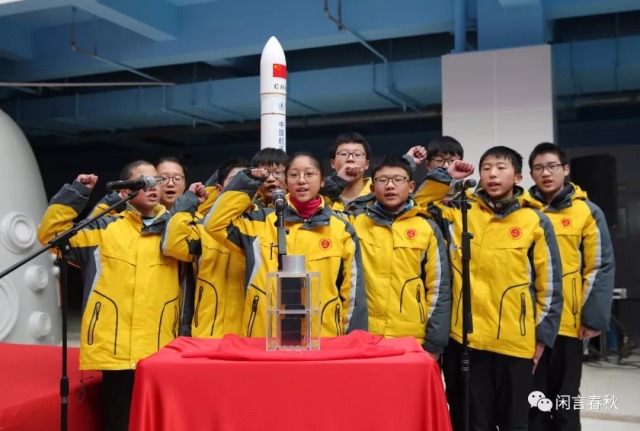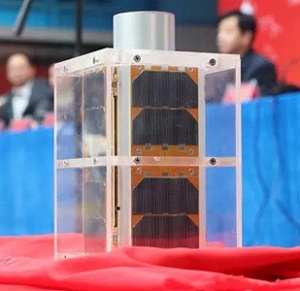Zhou Enlai student satellite launched
The 2U CubeSat Zhou Enlai 周恩来 developed with primary and middle school students was launched at 04:12 UT on Friday, January 19, 2018. 26 delegates from the satellite development student team in Huai’an who helped develop the CubeSat were at the Jiuquan Satellite Launch Center for the launch.
The satellite is named after the first Premier of the PRC, Zhou Enlai, who was born in Huai’an and held office from October 1949 until January 1976.
Zhou Enlai is listed as HA-1 on the IARU Satellite Frequency Coordination pages. It carries an FM transponder and has SSTV capability, the frequencies are at http://www.amsatuk.me.uk/iaru/finished_detail.php?serialnum=589
Also on the launch were the 6U CubeSats Xiaoxiang-2 (TY-2) and Yizhuang QuanTuTong-1 (QTT 1 / TY-6) developed by TianYi Research Institute in Changsha, Hunan Province, also known as SPACETY. TY-2 carries four experiments, testing optical fiber sensing technology, space radio software, Amateur Radio and image stabilization while TY-6 carries navigation and communication payloads (including AIS) along with the Amateur Radio payload. TY2 and TY6 both operate in the 435, 2400, 5650 and 5830 MHz amateur satellite service bands, further information at http://www.amsatuk.me.uk/iaru/finished_detail.php?serialnum=556
Nico PA0DLO reports detailed Doppler measurements show that TY-2 is object 43155, 2018-008A, downlink: 435.350 MHz and TY-6 is either object 43157, 2018-008C, or 43158, 2018-008D, downlink: 436.100 MHz.
A Xinhua Net report on the Zhou Enlai CubeSat says:
The satellite was sent from its production base in Huai’an Youth Comprehensive Development Base in east China’s Jiangsu Province to Jiuquan Satellite Launch Center in northwest China’s Gansu Province Monday, where a CZ-11 solid fuel rocket is scheduled to put it into orbit Friday.
Twenty teenagers who participated in the development project accompanied the transport group to the launch center and will witness the lift-off.
Zhang Xiang, chief designer of the satellite, said that the nano-satellite, weighing 2 kilograms, is set to run in sun-synchronous orbit. Equipped with a HD optical camera, it can capture space photos with the highest resolution among those shot by other Chinese satellites for scientific education purpose.
Zhang said that the students had taken their spare time to join the development and groundbased simulation performance of the satellite, and had learnt to assemble and practice voice data transfer and telecommunication applications.
“A scientific satellite like this is like a teacher in space, carrying cameras or spectroscopes to study the upper atmosphere or to shoot space pictures of the stars. Students can grasp the mystery of the universe through the messages transmitted by the teacher,” said Zhang, a professor with Nanjing University of Science and Engineering.
Read the full story at http://www.xinhuanet.com/english/2018-01/17/c_136902466.htm
Spaceflight101 article https://spaceflight101.com/china-third-long-march-11-launch/
GBTimes article https://gbtimes.com/long-march-11-rocket-launches-five-small-chinese-satellites-and-canadian-cubesat
N2YO online real-time satellite tracking http://www.n2yo.com/
AMSAT-NA online orbital predictions http://www.amsat.org/track/
Keplerian Two Line Elements (TLEs) ‘Keps’ for new satellites launched in past 30 days
http://celestrak.com/NORAD/elements/tle-new.txt
Adding new satellites to SatPC32, Gpredict and Nova
https://amsat-uk.org/2013/11/23/adding-new-satellites-to-satpc32/
Get The Details…
m5aka
AMSAT-UK
Powered by WPeMatico





 100vw, 640px»></a></p>
<p class=) Artist’s impression of PicSat in space
Artist’s impression of PicSat in space
 100vw, 300px»></a></p>
<p class=) Zhou Enlai CubeSat
Zhou Enlai CubeSat
 100vw, 277px»>The time when AO-73 enters continuous sunlight, for the first time, is fast approaching. Current estimates show that this will commence on February 6th and last through until March 13th.</p>
<p>Obviously, the autonomous switching system that the spacecraft has been using to switch between amateur mode, with the transponder on in eclipse and educational mode with high power telemetry only in sunlight, will no longer work.</p>
<p>Already the periods of eclipse are reducing quite rapidly and we are therefore planning for manual mode switching to take be undertaken. This will start from the week beginning Jan 21st and will follow this initial plan.</p>
<p>Wednesday evening (UTC) or Thursday morning – switch to full time amateur mode – ie transponder on with low power telemetry.</p>
<p>Sunday evening (UTC) or Monday morning – switch to full time educational mode with high power telemetry only.</p>
<p>So if you are planning school demonstrations or particular DXpeditions please take this new schedule into account.</p>
<p>The team may have to flex this plan with experience as this situation was not allowed for in the original mission plan!</p>
<p>AO-73 / FUNcube-1 spin period and illumination December 2017<br /><a href=) https://amsat-uk.org/2017/12/03/ao73-spin-period-illumination/
https://amsat-uk.org/2017/12/03/ao73-spin-period-illumination/ 100vw, 640px»></a></p>
<p class=) CNUSail-1 Credit KARI-Blog
CNUSail-1 Credit KARI-Blog
